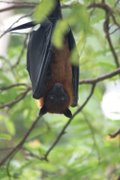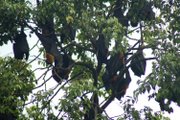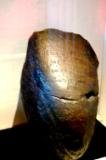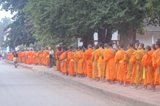One of the many myths propagated by Hollywood and which most people have come to believe must be that pythons are the most docile of reptiles. Away from Tinsel Town, the backstreets of some of Asian major cities or funfairs seemed to reinforce this. Chances are you would see pythons being handled quite easily although a bit heavily, adding more credence to the myth. In fact the more adventurous ones have been known to keep them as pets in their homes just to scare the hell out of unsuspecting friends. They are after all harmless creatures, according to the owners.
In the wild, pythons will lie coiled on the branches of trees and after selecting and successfully snaring their victims will grab them with their mouths and coil themselves around the targets. Using their tails for better leverage by holding on to the branches, they slowly pull the victims towards the tree and ever so slowly crushing the wind and life out of their prey, be they man or beast. It does not really matter that the pythons do not thoroughly messed up and meshed up your insides before devouring you because by that time you would be past caring whether your heads or rear ends enter first. By this stage victims would have already stopped breathing for quite a while from asphyxiation.
And what most people are quite unaware of is that pythons come in several versions for want of a better term. The Burmese version (Python molurus bivittatus) and the many other versions we shall merely refer to as the others. And the docile and seemingly harmless, albeit, gigantic snake that is handled quite easily is the Burmese version. The non-Burmese version, which I have had the pleasure of watching once, didn’t just slither around aimlessly but was quite ferocious. It had this ability to open its mouth to almost 180 degrees before randomly taking aim at parts of your anatomy worth taking shots at. Coupled with that are two rows of razor sharp teeth shaped very much like saws. Should the python be lucky with its target practice, then it could tear out chunks of flesh leaving certain parts of your esteemed self very much disfigured. And if anybody ever tells you pythons don’t have teeth, that person is talking rubbish and obviously had not really looked close enough. The snakes that don’t have teeth are boas. But then boas also give birth to their young instead of laying eggs like other snakes.
Of course, this is not to say that the non-Burmese python could not be handled. In the hands of experts they can, just as the case is with any type of snakes. Still I feel that there are easier ways to make a living than being a snake handler, although accountancy which pay hell of a lot more, may not be as exhilarating. Some people must be addicted to the adrenalin rush that comes with walking on the wild side daily just like others seemed to get a thrill out of riding their motorbikes on one wheel at traffic lights.
But make no mistake about it. Encountering a snake, the venomous ones that is (not counting pythons, boas and anacondas which are in a class of their own), can be as dangerous in the wild as it is at a funfair. No such thing as a cobra or king cobra with their venom glands (located just behind their eyes) being removed thereby rendering them harmless either. For without their venom such snakes would die as they are no longer able to feed and digest their food. What is probably done is that the handlers would extract the venom just before the show, thereby making them less fatal for at least a brief period of time.
I was told by a particular snake handler somewhere in Northeast Thailand that as part of his show he used to put the head of the king cobra in his mouth and grip it with his teeth. He had been doing that with the same snake for years so both were quite familiar with the trick. But one fine day that particular king cobra must have taken a sudden dislike for his breath and proceeded to sink its fangs into the man’s tongue. The man ended up in intensive care for a few weeks. The snake was returned to its cage without being harmed. It is taboo to kill a snake for the people of Ban Khok Sanga in Khon Kaen Province. The king cobras are always treated as friends. And with friends like that you certainly don’t need enemies, ever.
Meanwhile Chachoengsao Province, just to the north of Bangkok, is home to another type of creature, which some may find just as squeamish as snakes. These are the giant fruit bats or what some people call flying fox. They do indeed look like foxes with wings and are the size of chickens, the adults weighing at least more than a kilogram. The Thais call bats khang khao, roughly translated as the ones with the extremely smelly (in a fishy sort of way) chin. It is supposed to be an exotic cuisine in some kitchens. But I was told that when preparing a dish of bat curry or whatever, care must be taken never to break the saliva glands, otherwise the meat is useless because it is too smelly to eat. Thus the name khang khao. Some people have said their flesh tastes better than chicken and I fear I have to just take their word for it. But then again those who like to eat the meat of exotic animals always say that, be they dogs or frogs. Every meat on earth seemed to taste better than chicken meat, yet every body seemed to be eating chicken with such relish. All I can say is go eat a komodo dragon, then come back and tell me the meat tastes better than chicken meat.
There seemed to be nothing remarkable about these particular group of fruit bats if not for the fact that they seemed to be extraordinarily smart. They have chosen to make their homes on trees at the Wat Pho Bang Rak, thereby ensuring that there is almost zero chance of any of them ever finding itself as the main dish at some exotic dinner. They leave the temple compound before night fall to feed at the nearby forests which make up the Khao Yai National Park and return just before dawn to sleep hanging upside down. There must be thousands of them perched on the branches from batman and batgirl to bat mama, bat papa and bat kids. Being blind as a bat during the day, the bats allow you to get up close and photograph them. It couldn’t just have been survival instinct that told them a temple is a safe haven. It must be extra sensory perception. To kill any of these creatures, while they are in the temple compounds would have been a cardinal sin.
Another creature had also found temples to be safe havens. These equally clever species of catfish are found in rivers situated near temples. Unlike the bats, the fish are, however, more commonly seen. As they make their home in the temple area, again no one is allowed to catch these fish. They have become rather pampered, though, relying on kind tourists for their daily food of bread and fish pellets. Most have grown to a few kilos and would have fetched quite a price at the market. But unlike some of their distant cousins in Malaysia, they never venture beyond the temple areas. Somebody once pointed out to me that in Malaysia they are called ikan jelawat. In Thailand, they are more popularly known as the smart catfish.
Thursday, June 28, 2007
Thursday, June 07, 2007
Live by the sword, die by the sword
“A cobra can strike twice the distance its head is raised while a king cobra three times,” the Director of the Wildlife Department pointed out to me.
What this means basically is that if the cobra raised its head two feet above the ground it can lunge a distance of four feet, while for a king cobra the distance would be six feet. But not to worry, after a cobra or king cobra had struck once and missed, they need some time to regain their energy before delivering the second strike. Their heads would be raised, hooded and all menacing, but basically harmless for 10 seconds at least. If you are Carl Lewis, you would be a hundred metres away by the time the snake is ready to deliver the second strike. If you could not quite match Mr Lewis in speed or need a calculator to work out the snake’s deadly range then the next best thing to do is add an extra five metres to whatever answer you derive from your calculations. A 10 metre head start does not guarantee you would automatically outrun the king cobra should it decide to seriously give chase. But at least nobody can accuse you of being an idiot for standing too close to the reptile. And please bear in mind also that an adult king cobra can raise itself to about five feet and look you straight in the eye. Not a comforting thought, eh?
This conversation I was having with the Director of Wildlife Department was during a snake show at a village call Ban Khok Sa-nga in Khon Kaen Province, Northeast Thailand. I was acting as chaperone to a group of snake handlers from the Perlis Snake Farm who had been invited to perform at the said village, located 49km out of Khon Kaen town. Villagers in Ban Khok Sa-nga seemed to have very little fear of king cobras, which are kept as pets in most households.
Meanwhile up on stage a Thai snake handler was having a “boxing match” with a king cobra, slapping the snake’s cheek and darting out of the way every time it struck accompanied by a roar from the crowd. He was the village champion, a man just in his early 20s. Frustrated and certainly irritated, the snake at last gave up, unhooded its head and glided away looking for a dark corner to hide. That is what most snakes like doing, slither into a dark damp corner. Not very different from a few reptiles posing as mammals that I have encountered.
That particular snake secure at last in a box, out came a bigger one. A different snake handler this time pitted his agility against the new opponent. Again man proved to be too fast for the snake although he did not exactly stay the required distance my friend from the Wildlife Department had told me was the safe distance. But then they are all professionals and I on the other hand have this irrational fear of snakes, especially the venomous ones. Came from encountering cobras too many times as a child growing up on the outskirts of Kota Bharu in the 1960s. One day while home alone I also saw a pair of cobras slither under the house. We live in a house on stilts in those days. A cobra also killed one of my mother’s cat. It was soon put to rest, the snake that is, by a group of neighbours armed with bamboo stakes. In a terribly Hollywod or Bollywood manner, the cat actually waited for my mother to come home from work before taking its final breath.
According to those in the know, you can only kill a cobra with bamboo stakes though I reckon a baseball bat or golf club would also do the job if one is at hand. Only thing is that with a bamboo stake you can stand 10 feet away and have a go at it, while with a golf club or baseball bat you would have to get up very close and personal to do the job. Shy a creature as it may be a cobra cornered is definitely going to be in no mood to let you have a go at it without puuting up some sort of defence. And if you do not have the agility of a mongoose then you may end up ith a few love bites on your ankles. I was told that for some reason or other to keep snakes out of your compound sprinkle sulphur around your house. But personally I have found that kafir lime seemed to work better because sulphur tends to get washed away very quickly when it rains.
It was also pointed out to me that it is wrong to say that snakes or cobras in particular are poisonous. It is not, which explains why some people find their meat a delicacy. Others say drinking cobra’s blood is also supposed to cleanse your own blood. This accounted for the number of shops willing to slaughter cobras just so that you can clean your bad blood. Silly me, since all this while I thought drinking eight pints of plain water is good enough to get your kidneys to do the job of cleansing your blood. It seemed that some people had discovered a easier although somewhat less humane way to do the job. Personally I find going to the fridge for water a lot less distressing than going to the forests and trying to bag a cobra.
All snakes, however, are venomous, especially the ones whose heads are more or less triangular in shape. A baby king cobra, just hatched, already come equipped with enough venom to kill an animal a few times its size. A drop of venom from a king cobra or cobra is enough to kill 40 human adults or a horse. That should give you a good idea of how potent and dangerous their bite could be. Regardless of whether it is a fully grown adult or just a cute little baby. Certainly a case of the bite being more lethal than the bark. Strangely enough, the Thai name for a cobra is ngu hao (translated as barking snake). I did not find out whether cobras do indeed bark. I did not hear any barking from 10 feet away and have no desire to get any closer or give it a tight slap just to see if it emulate a dog. As a word of caution, no matter how much you desire to do so (especially the women out there) kindly refrain from giving a baby king cobra a cuddle even if your maternal instincts were deeply aroused.
Now we come to the who wants to be a millionaire questions:
After being bitten by a cobra or king cobra, how much time would you have left? The answer is cobra – 40 minutes, king cobra – 20 minutes (more or less). Next question, is it safe to suck the venom out with your mouth? Just in case you have no suction pump at hand. In theory, yes, provided you do not have a cavity. If not, the venom is now entering your blood stream through two channels. Good luck. Third question, why are the venom glands (located just behind its eyes) not removed for cobras used in shows? Removing the glands would kill the snake because it needs the venom to kill its prey and digest the food. Fourth question, why is it called a king cobra? Because it eats other snakes (including common cobras).
And the most important question of all, why the headline above? Well, our local Khon Kaen hero, the village champion had his last show a few weeks after I saw him performing. He made two mistakes that fateful day. First was not getting out of the way fast enough. The snake’s fangs went through his jeans and puncture the skin in his knee. Second mistake was thinking that since he had been bitten before he would have more resistance to the venom, so he continued with the show instead of seeking immediate medical treatment. It proved to be a fatal miscalculation on his part.
What this means basically is that if the cobra raised its head two feet above the ground it can lunge a distance of four feet, while for a king cobra the distance would be six feet. But not to worry, after a cobra or king cobra had struck once and missed, they need some time to regain their energy before delivering the second strike. Their heads would be raised, hooded and all menacing, but basically harmless for 10 seconds at least. If you are Carl Lewis, you would be a hundred metres away by the time the snake is ready to deliver the second strike. If you could not quite match Mr Lewis in speed or need a calculator to work out the snake’s deadly range then the next best thing to do is add an extra five metres to whatever answer you derive from your calculations. A 10 metre head start does not guarantee you would automatically outrun the king cobra should it decide to seriously give chase. But at least nobody can accuse you of being an idiot for standing too close to the reptile. And please bear in mind also that an adult king cobra can raise itself to about five feet and look you straight in the eye. Not a comforting thought, eh?
This conversation I was having with the Director of Wildlife Department was during a snake show at a village call Ban Khok Sa-nga in Khon Kaen Province, Northeast Thailand. I was acting as chaperone to a group of snake handlers from the Perlis Snake Farm who had been invited to perform at the said village, located 49km out of Khon Kaen town. Villagers in Ban Khok Sa-nga seemed to have very little fear of king cobras, which are kept as pets in most households.
Meanwhile up on stage a Thai snake handler was having a “boxing match” with a king cobra, slapping the snake’s cheek and darting out of the way every time it struck accompanied by a roar from the crowd. He was the village champion, a man just in his early 20s. Frustrated and certainly irritated, the snake at last gave up, unhooded its head and glided away looking for a dark corner to hide. That is what most snakes like doing, slither into a dark damp corner. Not very different from a few reptiles posing as mammals that I have encountered.
That particular snake secure at last in a box, out came a bigger one. A different snake handler this time pitted his agility against the new opponent. Again man proved to be too fast for the snake although he did not exactly stay the required distance my friend from the Wildlife Department had told me was the safe distance. But then they are all professionals and I on the other hand have this irrational fear of snakes, especially the venomous ones. Came from encountering cobras too many times as a child growing up on the outskirts of Kota Bharu in the 1960s. One day while home alone I also saw a pair of cobras slither under the house. We live in a house on stilts in those days. A cobra also killed one of my mother’s cat. It was soon put to rest, the snake that is, by a group of neighbours armed with bamboo stakes. In a terribly Hollywod or Bollywood manner, the cat actually waited for my mother to come home from work before taking its final breath.
According to those in the know, you can only kill a cobra with bamboo stakes though I reckon a baseball bat or golf club would also do the job if one is at hand. Only thing is that with a bamboo stake you can stand 10 feet away and have a go at it, while with a golf club or baseball bat you would have to get up very close and personal to do the job. Shy a creature as it may be a cobra cornered is definitely going to be in no mood to let you have a go at it without puuting up some sort of defence. And if you do not have the agility of a mongoose then you may end up ith a few love bites on your ankles. I was told that for some reason or other to keep snakes out of your compound sprinkle sulphur around your house. But personally I have found that kafir lime seemed to work better because sulphur tends to get washed away very quickly when it rains.
It was also pointed out to me that it is wrong to say that snakes or cobras in particular are poisonous. It is not, which explains why some people find their meat a delicacy. Others say drinking cobra’s blood is also supposed to cleanse your own blood. This accounted for the number of shops willing to slaughter cobras just so that you can clean your bad blood. Silly me, since all this while I thought drinking eight pints of plain water is good enough to get your kidneys to do the job of cleansing your blood. It seemed that some people had discovered a easier although somewhat less humane way to do the job. Personally I find going to the fridge for water a lot less distressing than going to the forests and trying to bag a cobra.
All snakes, however, are venomous, especially the ones whose heads are more or less triangular in shape. A baby king cobra, just hatched, already come equipped with enough venom to kill an animal a few times its size. A drop of venom from a king cobra or cobra is enough to kill 40 human adults or a horse. That should give you a good idea of how potent and dangerous their bite could be. Regardless of whether it is a fully grown adult or just a cute little baby. Certainly a case of the bite being more lethal than the bark. Strangely enough, the Thai name for a cobra is ngu hao (translated as barking snake). I did not find out whether cobras do indeed bark. I did not hear any barking from 10 feet away and have no desire to get any closer or give it a tight slap just to see if it emulate a dog. As a word of caution, no matter how much you desire to do so (especially the women out there) kindly refrain from giving a baby king cobra a cuddle even if your maternal instincts were deeply aroused.
Now we come to the who wants to be a millionaire questions:
After being bitten by a cobra or king cobra, how much time would you have left? The answer is cobra – 40 minutes, king cobra – 20 minutes (more or less). Next question, is it safe to suck the venom out with your mouth? Just in case you have no suction pump at hand. In theory, yes, provided you do not have a cavity. If not, the venom is now entering your blood stream through two channels. Good luck. Third question, why are the venom glands (located just behind its eyes) not removed for cobras used in shows? Removing the glands would kill the snake because it needs the venom to kill its prey and digest the food. Fourth question, why is it called a king cobra? Because it eats other snakes (including common cobras).
And the most important question of all, why the headline above? Well, our local Khon Kaen hero, the village champion had his last show a few weeks after I saw him performing. He made two mistakes that fateful day. First was not getting out of the way fast enough. The snake’s fangs went through his jeans and puncture the skin in his knee. Second mistake was thinking that since he had been bitten before he would have more resistance to the venom, so he continued with the show instead of seeking immediate medical treatment. It proved to be a fatal miscalculation on his part.
Subscribe to:
Posts (Atom)


















